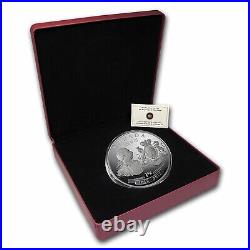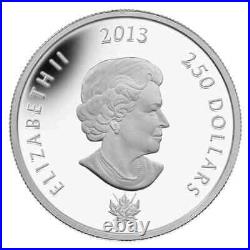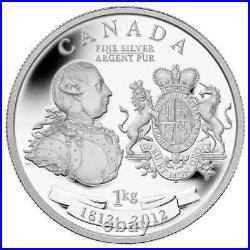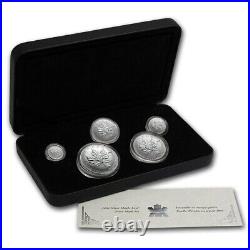


A gorgeous proof silver coin in wooden case. The coin weighs 1000 grams and is 102.1 mm in diameter. The coin is double dated on the reverse. It is minted to the standard of 99.99% purity!! The obverse has the image of the Queen (by Susanna Blunt). A uniquely numbered certificate is included. Very limited mintage of only 225. From the earliest days of North American colonisation, European nations presented silver medallions to First Nations leaders as tokens of respect and friendship, gratitude for service, and at the signing of treaties. From his ascension to the British throne in 1760, King George III’s peace medals featured a reverse image bearing his royal arms and, on the obverse, his bust. The reverse features the reverse and obverse sides of the King George III Peace Medal rendered in striking detail, as it appeared in 1812, including the young, armoured bust of King George III wearing the ribbon of the Order of the Garter, his beribboned hair curled above his right ear. To the right of this effigy is an image of the Arms of George III that would have appeared on the reverse of the peace medals at the time of the War of 1812. These Arms include a central shield quartered into quadrants representing England (three lions’passant guardant’) and Scotland (a lion’rampant’ within a framed detail); France (three fleurs-de-lys); Ireland (a stringed harp); and Hanover, Brunswick, Luneburg, and Westphalia (bottom right quadrant). The shield is topped by the crown of Charlemagne and encircled by the garter symbolizing the Order of the Garter and engraved with the Order’s motto,’Honi soit qui mal y pense’ (Shamed be he who thinks evil of it). The arms is supported by the lion of the House of Plantaganet and the unicorn traditionally representing purity. Beneath the Arms is a ribbon bearing the royal motto,’Dieu, et Mon Droit’ (God and My Right) flanked by the symbolic rose and thistle of British monarchy. The reverse is embossed with the words,’CANADA,”Fine Silver/Argent Pur,’ the metal weight of’1 kg,’ and the dates’1812 – 2012′ to commemorate the bicentennial of the War of 1812. The obverse, which features the effigy of Her Majesty Queen Elizabeth II by Susanna Blunt, also features a unique stylized maple leaf symbol with the year’1812. This marker is the Government of Canada’s official symbol for commemorating the bicentennial of the War of 1812. Special Features: – A unique product rich in tradition and artistry, featuring the unmatched quality of Royal Canadian Mint 99.99% pure silver. A stunning heraldic commemoration of the bicentennial of a pivotal moment in pre-confederation Canadian, British, and American history. Fits beautifully into any Canadian, historical, international, or silver coin collection. A beautiful way to preserve, celebrate, and learn about our rich shared history and the seeds of Canadian unity and identity. Created to commemorate the bicentennial of the War of 1812, this unique coin is part of a larger collection of Royal Canadian Mint numismatic works devoted to commemorating the 200th anniversary of a vital event in Canadian history. An attractive collectible for numismatists, and silver lovers of Canadian and War of 1812 history. Product Specifications: – Face Value: 250 dollar – Mintage: 600 – Composition: 99.99% Pure silver – Weight (g): 1,000 – Diameter (mm): 102.1 – Edge: Serrated – Finish: Proof – Certificate: Serialized – Artist: RCM engravers’ representation of the King George III Peace Medal. Packaging: – Coin is encapsulated and presented in a Royal Canadian Mint-branded maroon clamshell case, lined with black flock and protected by a black sleeve. Complete Certificate Text: 2012: Bicentennial of the War of 1812 The War of 1812 was a fundamental turning point in Canada’s history: it profoundly influenced British North America’s (Canada’s) sense of identity and united French and English-speaking inhabitants, Aboriginal communities, farmers, soldiers, artisans, and others, in an effort to preserve their ways of life from American invasion. From the struggle emerged exceptional accounts of some of Canada’s proudest moments. These stories and the heroes that arose from them exemplified the extraordinary characteristics required to defend British North America, and have become important symbols and enduring narratives in the history and evolution of today’s Canada. Honour Among Allies: The Tradition of Peace Medals From the earliest days of North American colonisation, European nations presented silver medallions to First Nations leaders as tokens of respect and friendship, gratitude for service, and at the signing of treaties. Historical evidence suggests that these physical signs of loyalty not only helped to ease tensions caused by cultural and linguistic differences between First Nations peoples and European settlers, but were revered by First Nations recipients and, in some cases, passed down through generations. In Canada, the practice of giving peace medals to First Nations chiefs dates back to the early 1670s, when such medals were handed out by the government of King Louis XIV of France. Around the same time, the British government of King Charles II was presenting similar medals to First Nations peoples in British colonies in what is now the eastern United States. When Britain gained control of France’s North American holdings following the Seven Years’ War (1756 to 1763), the French peace medals were replaced by British peace medals featuring King George II and, later, his grandson George III. The reverse image included a central shield quartered into quadrants representing England (three lions’passant guardant’) and Scotland (a lion’rampant’ within a framed detail); France (three fleurs-de-lys); Ireland (a stringed harp); and Hanover, Brunswick, Luneburg, and Westphalia (bottom right quadrant). The shield is topped by the crown of Charlemagne and encircled by the garter of the Order of the Garter, which is engraved with the Order’s motto,’Honi soit qui mal y pense,’ which means,’Shamed be he who thinks evil of it. The shield is supported by the lion of the House of Plantaganet and the unicorn traditionally representing purity. Beneath the Arms is a ribbon bearing the royal motto,’Dieu, et Mon Droit,’ which means,’God and My Right’ flanked by the symbolic rose and thistle of British monarchy. The obverse features the effigy of a young George III in armour. The specific elements of the coat of arms changed over the years, as the holdings of the British empire changed, and following the War of 1812, the bust of the King was replaced by an effigy of him as a much older man. Following the American Revolutionary War (1775 – 1783), agents of the American government actively sought out British peace medals held by First Nations peoples. These expeditions were designed to seize First Nations loyalty and replace these British medals with new series of medals bearing American presidents and symbolic images. By the onset of the War of 1812, this ever- shifting manipulation of medals and other tokens (including silver arm and hat bands, belt buckles, flags, stylized tomahawks, and more) Two Worlds Join Hands One of the most famous of the King George peace medals was worn by Shawnee war-chief Tecumseh, who was given a peace medal after meeting the British before the War of 1812. He wore the medal on a wampum cord around his neck, and it remained an important personal token for the great chief until his death at the Battle of the Thames on October 5, 1813. GST or HST EXEMPT item. Usually MUCH cheaper for multiples of this item or similar weight/size.. your item is being sent by a cheaper and slower but fully trackable method (3-6 weeks typically). I have no control over how long the postal systems take to get it to you. This item is in the category “Coins & Paper Money\Bullion\Silver\Coins”. The seller is “vbref63″ and is located in this country: CA. This item can be shipped to Canada, all countries in Europe, all countries in continental Asia, United States, Mexico, Brazil, Australia.
- Coin: Canadian Maple Leaf
- Composition: Silver
- Year: 2012
- Strike Type: Proof
- Fineness: 0.9999
- Grade: Ungraded
- Precious Metal Content per Unit: 1 kg
- Country/Region of Manufacture: Canada
- Brand/Mint: Royal Canadian Mint
- Total Precious Metal Content: 32.13 oz
- Certification: Uncertified

